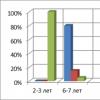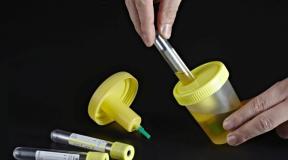Amoxiclav tablets instructions for use. Antibiotic amoxiclav for adults. Description of release forms
thanks
The site provides background information for informational purposes only. Diagnosis and treatment of diseases must be carried out under the supervision of a specialist. All drugs have contraindications. A specialist consultation is required!
Composition
 The composition of the drug Amoxiclav includes the antibiotic amoxicillin trihydrate and the potassium salt of clavulanic acid, which is an enzyme inhibitor. Refers to pharmacological group penicillins.
The composition of the drug Amoxiclav includes the antibiotic amoxicillin trihydrate and the potassium salt of clavulanic acid, which is an enzyme inhibitor. Refers to pharmacological group penicillins. Release form
Produced in the form:- film-coated tablets;
- powder for suspensions;
- lyophilized powder for injection.
The 625 mg tablet contains 500 mg of amoxicillin, 125 mg of clavulonic acid.
Excipients are:
- silicon dioxide (colloid);
- croscarmellose (sodium salt);
- magnesium stearate;
- talc;
- hypromellose;
- ethyl cellulose;
- polysorbate;
- titanium dioxide;
- triethyl citrate.
The suspension powder is available in dark glass vials, one per box. There is also a measuring spoon. The usual ready-made suspension contains 125 and 31.25 mg of active ingredients, respectively. When preparing the Amoxiclav Forte suspension, 5 ml contains twice as many active ingredients - 250 and 62.5 mg, respectively. Excipients are:
- lemon acid;
- sodium citrate;
- sodium benzoate;
- carmellose sodium;
- colloid of silicon dioxide;
- sodium saccharinate;
- mannitol;
- strawberry and wild cherry flavors.
pharmachologic effect
 The combination of amoxicillin with clavulanic acid is unique in its own way. Amoxicillin and other antibiotics of the penicillin group cause the death of bacterial cells by binding to their surface receptors. However, most bacteria during the use of the drug have learned to destroy this antibiotic using the beta-lactamase enzyme. Clavulanic acid reduces the activity of this enzyme, due to which of this drug a very wide spectrum of action. It even kills bacteria strains that are resistant to amoxicillin. The drug has a pronounced bacteriostatic and bactericidal effect on all types of streptococci (with the exception of methicillin-resistant strains), echinococci, listeria. Sensitive to amoxiclav and gram-negative bacteria:
The combination of amoxicillin with clavulanic acid is unique in its own way. Amoxicillin and other antibiotics of the penicillin group cause the death of bacterial cells by binding to their surface receptors. However, most bacteria during the use of the drug have learned to destroy this antibiotic using the beta-lactamase enzyme. Clavulanic acid reduces the activity of this enzyme, due to which of this drug a very wide spectrum of action. It even kills bacteria strains that are resistant to amoxicillin. The drug has a pronounced bacteriostatic and bactericidal effect on all types of streptococci (with the exception of methicillin-resistant strains), echinococci, listeria. Sensitive to amoxiclav and gram-negative bacteria: - bordetella;
- brucella;
- klebsiella;
- moraxella;
- Proteus;
- shigella;
- clostridium and others.
Indications
The use of this antibiotic is prescribed for the treatment of various infectious diseases:- Diseases respiratory tract- sinusitis (acute or chronic), otitis media, retropharyngeal abscess, bronchitis, tonsilopharyngitis, pneumonia and others.
- Diseases urinary tract- cystitis, pyelonephritis, urethritis and others.
- Gynecological infections, endometritis, septic abortion, salpingitis, and others.
- Inflammation of the biliary tract (cholangitis, cholecystitis).
- Connective and bone tissue infections.
- Infections of soft tissues and skin (bites, phlegmon, wound infection).
- Odontogenic infections in which the pathogen enters the body through cavities in the teeth.
Tablets and powder Amoxiclav - instructions for use
 Amoxiclav is prescribed in different ways. The method of administration depends on the age and weight of the patient, the severity of the infection, the condition of the kidneys and liver. The optimal time to use the drug is when you start eating. The course of taking this medication lasts from 5 to 14 days, it cannot be used longer.
Amoxiclav is prescribed in different ways. The method of administration depends on the age and weight of the patient, the severity of the infection, the condition of the kidneys and liver. The optimal time to use the drug is when you start eating. The course of taking this medication lasts from 5 to 14 days, it cannot be used longer. For children under 12 years old- 40 mg per kilogram of body weight per day.
For children weighing more than 40 kg, the drug is prescribed as for adults.
Adults are prescribed: 375 mg tablets are taken every 8 hours, 24 hours a day, 625 mg tablets every 12 hours. When prescribing medication for treatment severe infections doses of 625 mg every 8 hours or 1000 mg every 12 hours are used.
It should be noted that the tablets may differ in the proportions of the active ingredients. Therefore, you cannot replace the 625 mg tablet (500 g of amoxicillin and 125 g of clavulanic acid) with two 375 mg tablets (250 g of amoxicillin and 125 g of clavulanic acid).
For the treatment of odontogenic infections, the following scheme is used. 375 mg tablets are taken every 8 hours, around the clock. Tablets 625 mg after 12 hours.
If it is necessary to use a drug for the treatment of patients with kidney disease, the creatinine content in the urine must be taken into account. Patients with liver diseases require constant monitoring of its function.
Powder for preparation of suspensions is used for newborns and children up to 3 months... Dosing is carried out using a special measuring pipette or spoon. The dosage is 30 mg of amoxicillin per kilogram of body weight, twice a day.
For children over three months old for mild and moderate infections - 20 mg / kg of weight, and for severe - 40 mg / kg. The second dose is also used in the treatment of deep infections - otitis media, sinusitis, bronchitis, pneumonia. An instruction is attached to this medicine, in which there are special tables that allow you to calculate the doses of the drug necessary for children as accurately as possible.
The maximum permissible daily dose of amoxicillin for children is 45 mg / kg of body weight, for adults - 6 grams. Clavulanic acid can be taken per day no more than 600 mg for adults and 10 mg / kg for children.
Description of release forms
Suspension
 Powder for suspension for oral administration is used for administration to children. Five milliliters of the finished suspension contains 250 mg of amoxicillin trihydrate and 62.5 mg of the potassium salt of clavulanic acid. Or 5 ml may contain 125 mg of amoxicillin and 31.5 mg of clavulanic acid. It contains sweet substances and fruit flavors to give the suspension a pleasant taste. Powder for suspension preparation is packaged in dark glass vials. The volume of the bottles is 35, 50, 70 or 140 ml. A dosing spoon is put into the box with the bottle.
Powder for suspension for oral administration is used for administration to children. Five milliliters of the finished suspension contains 250 mg of amoxicillin trihydrate and 62.5 mg of the potassium salt of clavulanic acid. Or 5 ml may contain 125 mg of amoxicillin and 31.5 mg of clavulanic acid. It contains sweet substances and fruit flavors to give the suspension a pleasant taste. Powder for suspension preparation is packaged in dark glass vials. The volume of the bottles is 35, 50, 70 or 140 ml. A dosing spoon is put into the box with the bottle. Pills
This medicine comes in the form of film-coated tablets, which are white or beige-white in color. The tablets have an oval biconvex shape.One 625 mg tablet contains 500 mg of amoxicillin trihydrate with 125 mg of clavulanic acid (potassium salt).
Tablets can be produced in plastic cans (15 tablets each) or in aluminum blisters of 5 or 7 pieces.
Tablets 1000 mg are also coated, have an oblong shape with beveled edges. On one side of them, the impression "AMC" is applied, on the other - "875/125". They contain 875 mg of antibiotic and 125 mg of clavulanic acid.
Amoxiclav 125
This is the name of a powder for preparing a suspension, containing 125 mg of amoxicillin and 31.5 mg of clavulanic acid in 5 ml. Available in bottles of 100 ml, in a cardboard box with a dosing spoon. The dosage is indicated in the section "Amoxiclav - instructions for use".Amoxiclav 250 ("Amoxiclav Forte")
This is also a powder for preparing a suspension, but it contains a double dose of amoxicillin - 250 mg in 5 ml and 62.5 mg of clavulanic acid. This suspension is called "Amoxiclav Forte" because of the increased dose of antibiotic in its composition. The dosage is indicated in the section "Amoxiclav - instructions for use".Amoxiclav 500
These are Amoxiclav tablets - 625 mg, containing 500 mg of the antibiotic itself. Application and doses are indicated in the section "Amoxiclav instructions for use", and the composition and properties - in the section "Amoxiclav tablets".Amoxiclav 875
These are Amoxiclav tablets - 1000 mg, containing 875 mg of the antibiotic itself, and 125 mg of clavulanic acid. Application and doses are indicated in the section on the method of administration of the drug, and the composition and properties - in the section "Amoxiclav tablets".Amoxiclav 625
The tablets contain 500 mg of amoxicillin and 125 mg of clavulanic acid. Application and doses are indicated in the section on the method of administration of the drug, and the composition and properties - in the section "Amoxiclav tablets".Amoxiclav 1000
The tablets contain 875 g of amoxicillin and 125 mg of clavulanic acid. Application and doses are indicated in the section on the method of administration of the drug, and the composition and properties - in the section "Amoxiclav tablets".Amoxiclav Kviktab
 Fast dissolving fruit flavored tablets containing either 500 mg of amoxicillin and 125 mg of clavulanic acid or 875 mg of amoxicillin and 125 mg of clavulanic acid.
Fast dissolving fruit flavored tablets containing either 500 mg of amoxicillin and 125 mg of clavulanic acid or 875 mg of amoxicillin and 125 mg of clavulanic acid. Contraindications
When taking the drug, liver dysfunction and jaundice (cholestatic) may occur, if this drug has already been used and the patient has an increased sensitivity to the components of the drug, or to all penicillins.Nervous system may react to taking the drug with headaches, dizziness, agitation, insomnia, seizures, inappropriate behavior or hyperactivity.
Liver. The indicators of liver function tests increase, including asymptomatic increases in the activity of AsAT and / or AlAT, alkaline phosphatase and the level of bilirubin in the blood serum.
Leather. The skin can react to the intake of amoxiclav with a rash, urticaria, angioedema, erythema multiforme, toxic epidermal necrolysis, exfoliative dermatitis, Stevens-Johnson syndrome develops less often.
urinary system
- there is the appearance of blood in the urine and interstitial nephritis.
At long-term use the drug may cause fever, oral candidiasis, and candidal vaginitis.
Amoxiclav during pregnancy
It is advisable not to use Amoxiclav during pregnancy. The exception is those cases when the benefits of taking the drug are higher than the harm they cause. Taking this medication during pregnancy increases the risk of necrotizing colitis in newborns.Amoxiclav for children
For children, powder for suspensions is used, ordinary and "Amoxiclav Forte". The method of application is described in the section Amoxiclav - method of application.Amoxiclav for angina
 Antibiotics for angina are prescribed only in cases of moderate and high severity. Amoxiclav as an antibiotic penicillin series, is often prescribed for tonsillitis. Its use is indicated only when the bacterial form of the infection has been confirmed, and the pathogenic microflora has been tested for sensitivity to this drug. In the treatment of angina in children, suspensions are used, for adults - tablets. In severe cases, injections of the drug are used.
Antibiotics for angina are prescribed only in cases of moderate and high severity. Amoxiclav as an antibiotic penicillin series, is often prescribed for tonsillitis. Its use is indicated only when the bacterial form of the infection has been confirmed, and the pathogenic microflora has been tested for sensitivity to this drug. In the treatment of angina in children, suspensions are used, for adults - tablets. In severe cases, injections of the drug are used. It must be remembered that antibiotics should not be used for a long time, as this increases the resistance of pathogenic microflora to them.
Compatibility with other medicines
- It is undesirable to use Amoxiclav and drugs at the same time indirect anticoagulants... This can cause an increase in prothrombin time.
- The interaction of Amoxiclav and allopurinol raises the risk of developing exanthema.
- Amoxiclav increases the toxicity of metatrexate.
- You can not use amoxicillin and rifampicin at the same time - these are antagonist preprates, combined use weakens the antibacterial effect of both.
- You can not prescribe amoxiclav together with tetracyclines or macrolides (these are bacteriostatic antibiotics), as well as sulfonamides due to a decrease in the effectiveness of this drug.
- Taking Amoxiclav reduces the effectiveness of contraceptives in pills.
Comparison with other drugs
What is better Amoxiclava?
When choosing an antibiotic for the treatment of any infection, it is necessary to be guided by the results of testing the pathogenic microflora for sensitivity to a specific antibiotic. It makes no sense to use a drug that does not kill bacteria - that is, does not cure. Therefore, the best antibiotic to which the patient's pathogenic microflora is sensitive will be.Amoxiclav or amoxicillin?
Amoxiclav is more effective drug than amoxicillin, since many pathogenic microorganisms have developed immunity to this antibiotic and have learned to destroy it, preventing it from showing its bactericidal effect. The addition of clavulanic acid to amoxicillin made this antibiotic much more active, expanding its range of action.Amoxiclav or Augmentin?
Augmentin - an analogue of Amoxiclav, contains the same active ingredients.Amoxiclav or Flemoxin?
Flemoxin is a drug containing only amoxicillin. Without the use of clavulonic acid, it has a smaller spectrum of action, therefore it is used only if the bacterial microflora is sensitive to this antibiotic.Amoxiclav or Sumamed?
The composition of Sumamed includes the antibiotic azithromycin, which has a wide spectrum of action. The choice should be made on the basis of checking the sensitivity of the pathogenic microflora to these two antibiotics. The side effects are similar.Alcohol compatibility
 During treatment with Amoxiclav, it is forbidden to take alcohol. Reception alcoholic beverages significantly reduces the antibacterial effect of the medication.
During treatment with Amoxiclav, it is forbidden to take alcohol. Reception alcoholic beverages significantly reduces the antibacterial effect of the medication. Synonyms and analogues
Synonyms:- Augmentin;
- Clavocin;
- Moxiclav.
- Amovikomb;
- Arlet;
- Bactoclav;
- Klamosar;
- Verclave;
- Medoclav;
- Lyclavus;
- Panclave;
- Ranklove;
- Rapiklav;
- Toromentin;
- Flemoklav;
- Ecoclave;
- Amoxicillin + clavulanic acid (Faizer) and others.
Reviews
Reviews of doctors
 Anna Leonidovna, therapist, Vitebsk.
Amoxiclav is much more effective in the treatment of various respiratory diseases than its analogue, amoxicillin. I prescribe a course of 5 days, after which it is mandatory to take drugs that restore microflora.
Anna Leonidovna, therapist, Vitebsk.
Amoxiclav is much more effective in the treatment of various respiratory diseases than its analogue, amoxicillin. I prescribe a course of 5 days, after which it is mandatory to take drugs that restore microflora. Veronika Pavlovna, urologist. g, Kryvyi Rih. This drug works great on bacterial infections genital tract. Rarely gives side effects, in parallel, I prescribe antifungal drugs, after taking - probiotics to restore normal microflora.
Andrey Evgenievich, ENT doctor, Polotsk. The use of this drug by injection allows you to quickly stop the manifestations of severe and moderate diseases of the ENT organs. The drug is good for treating otitis media. In addition, the sugary fruit suspension is well accepted by the patients.
Generics search service in Moscow
To love a woman in bed for a long time or to completely surrender to your man is one of the main pleasures of an adult. Sexual arousal does not always skyrocket. It so happens that the body needs help in order to tune in to intimacy itself and to have a partner. To do this, we propose to buy generics in Moscow. Inexpensive, proven from the point of view of composition, and most importantly - effective drugs will increase the potency of men, make sexual intercourse long and deeply satisfying.
Generiki.RU: what is it and how does it work?
Generics.RU- an aggregator through which you can order cheap generics in online pharmacies, whose prices and delivery conditions will suit you. The site gives out drugs on request, sorting them by cost, you choose the right one and order courier delivery around the city. In the presence of non-prescription drugs, dietary supplements and prescription drugs to increase potency.
We act as an intermediary between the client and the online pharmacy. The automated system searches for available generics and dietary supplements. You see the final search result, the most favorable offer for the current day is taken from each site and displayed on our site (search results are updated once a day). In our database there are exclusively sites that have existed for more than 5 years. This allows you to work only with reliable online pharmacies, suppliers, minimize risks and get more for you. low prices.
You fill out an application for the drug or dietary supplement you are interested in, our manager checks and confirms your application, clarifies your wishes (prescription for prescription drugs), after that the purchase department buys your order, the courier picks it up from the pharmacy and brings it to your home.
What can be found on our website?
The pharmacies we search for offer:
➤ Viagra(sildenafil citrate). A classic erection enhancer with proven efficacy. Thanks to him, a man quickly becomes aroused, becomes hardy in bed and is able to deliver sexual pleasure. The drug treats impotence, makes an erection powerful and long-lasting.
➤ Cialis(tadalafil). Another popular remedy for the quality improvement of sex. With the correct use of these tablets, not only men's health but also mood is steadily improved. The action lasts for 1-1.5 days.
➤ Levitru(vardenafil). A cheap generic drug for restoring erection and treating a number of problems associated with the genitourinary tract. The erection becomes powerful 2-3 hours after taking sucking tablets or powder dissolved in water, the effect lasts 6-8 hours.
➤ Avanafil... Pills to improve erection quick action: You will see the result in 15-20 minutes after taking it, when you start intimate communication with your partner. The effect will last 5-6 hours.
➤ Dapoxetine... A drug that prolongs sexual intercourse and provokes spasms of the pelvic muscles, which are necessary for ejaculation. Lasts 3-4 hours. It is used for sexual dysfunction and premature ejaculation.
⭐All products are certified! ⭐
For women
Also in pharmacies offering to buy generics in Moscow through our aggregator site, there are products for women - stimulating drops, tablets, dietary supplements, capsules. Women's drugs are mainly natural composition, taken 15-20 minutes before sex, increase the release of lubricant and increase the sensitivity of the genitals.
You can also order from the catalog:
- condoms;
- combined tablets (2-3 active ingredients in 1 product);
- fortifying dietary supplements, gently helping to cope with erectile dysfunction with prolonged use;
- sets of several pills differing in composition for restoring an erection (Trial) and simultaneously solving two problems - erectile dysfunction and premature ejaculation (Professional).
Why is it worth buying generics for potency on our aggregator site?
- By visiting us and entering the name of the drug in the search, you can find it at the best price, no need to go to the pharmacy, waste time and effort, our courier will do it for you and deliver the order in Moscow as soon as possible.
- Using the services of our company, you can buy generics in Moscow wholesale and retail at low prices, as well as dietary supplements to improve erection, condoms, beauty and health products delivered from pharmacies in Moscow.
- We offer a flexible loyalty system for regular customers, after the first purchase you will receive a discount.
- Secret promo codes and ongoing promotions posted on the site ensure that you always receive low prices and favorable terms of service.
- If you find prices lower than in our database, tell us where it is cheaper and we, after checking the legality of the specified pharmacy, will include it in the search.
- Applications made on the site are accepted around the clock. Applications are accepted through the free hotline from 10 am to 9 pm Moscow time.
- Our clients have the opportunity of a free consultation on the action of any drug from a professional pharmacist, if you have questions about the regimen and contraindications.
- Convenient site search, comparison and analysis of prices for all offers on the Internet.
- Each product we sell has the necessary documentation, references and certificates.
- When placing an order in Generiki.RU, you can forget about embarrassing moments - you no longer need to personally meet with a pharmacist to explain your problem. We will blush for you, it's not difficult for us!
Amoxiclav
Buy Amoxiclav in pharmacies
DOSAGE FORMS
coated tablets 875mg / 125mg
film-coated tablets 875mg + 125mg
MANUFACTURERS
Lek dd (Slovenia)
GROUP
Combined antimicrobial agents
COMPOSITION
Active ingredients: 875 mg of amoxicillin in the form of trihydrate and 125 mg of clavulanic acid in the form of potassium salt.
INTERNATIONAL NON-PATENTED NAME
Amoxicillin + Clavulanic Acid
SYNONYMS
Amoxiclav Kviktab, Arlet, Augmentin, Augmentin EC, Augmentin SR, Klamosar, Medoklav, Panklav, Ranklav, Rapiklav, Sinulox, Sinulox RTU, Flemoklav Solutab, Ekoklav
PHARMACHOLOGIC EFFECT
The drug is a combination of amoxicillin and clavulanic acid. Amoxicillin is a semi-synthetic penicillin (beta-lactam antibiotic) that inhibits one or more enzymes (often referred to as penicillin-binding proteins, PBPs) in the biosynthetic pathway of peptidoglycan, which is an integral structural component of the bacterial cell wall. Inhibition of peptidoglycan synthesis leads to a loss of cell wall strength, which usually leads to lysis and death of microbial cells. Amoxicillin is destroyed by the action of beta-lactamases produced by resistant bacteria, thus the spectrum of activity of amoxicillin alone does not include microorganisms that produce these enzymes. Clavulanic acid is a beta-lactam structurally related to penicillins. It inhibits some beta-lactamases, thereby preventing the inactivation of amoxicillin and expands its spectrum of activity, including bacteria that are usually resistant to amoxicillin, as well as to other penicillins and cephalosporins. By itself, clavulanic acid has no clinically significant antibacterial effect. The drug has a bactericidal effect in vivo on the following microorganisms: Gram-positive aerobes. Staphylococcus aureus, Streptococcus pneumoniae, Streptococcus pyogenes. Gram-negative aerobes. Enterobacter spp, Escherichia coli, Haemophilus influenza, Species of the genus Klebsiella, Moraxella catarrhalis (Branhamella catarrhalis). The drug has an in vitro bactericidal effect on the following microorganisms (however, clinical dependence is still unknown). Gram-positive aerobes. BacilHs anthracis. Species of the genus Corynebacterium, Enterococcus faecalis, Enterococcus faecium, Listeria monocytogenes, Nocardia asteroids, Coagulase-negative staphylococci (including Staphylococcus epidermidis) Streptococcus agalaciiae. Other species of the genus Streptococcus Streptococcus viridians. Gram-positive anaerobes. Species of the genus Clostridium, Species of the genus Peptococcus, Species of the genus Peptostreptococcus. Gram-negative aerobes. Bordetella pertussis, Species of the genus Brucella, Gardnerella vaginalis, Helicobacter pylori, Species of the genus Legionella, Neisseria gonorrhoeae, Neisseria meningitides, Pasteurella multocida, Proteus mirabilis, Proteus vulgaris. Gram-negative anaerobes. Species of the genus Bacteroides (including Bacteroides fragilis), Species of the genus Fusobacterium. Others: Borrella burgdorferi, Chlamydia spp. , Leptospira icterohaemorrhagiae, Treponema pallidum. Some strains of these bacterial species produce beta-lactamases, which contribute to their insensitivity to monotherapy with amoxicillin. Pharmacokinetics. The main pharmacokinetic parameters of amoxicillin and clavulanic acid are similar. Amoxicillin and clavulanic acid dissolve well in aqueous solutions with a physiological pH value and after taking the drug inside are quickly and completely absorbed from gastrointestinal tract(GIT), The absorption of the active substances amoxicillin and clavulanic acid is optimal if taken at the beginning of a meal. The bioavailability of amoxicillin and clavulanic acid after oral administration is about 70%. Peak plasma concentrations are reached approximately 1 hour after ingestion. The maximum concentration values for amoxicillin (depending on the dose) are 3-12 μg / ml, for clavulanic acid - about 2 μg / ml. When using the drug, the concentration of amoxicillin / clavulanic acid in plasma is similar to those for oral administration of the corresponding doses of amoxicillin or clavulanic acid separately in equivalent doses. Both components are characterized by a good volume of distribution in various organs, tissues and body fluids (including in the lungs, organs abdominal cavity; adipose, bone and muscle tissues; pleural, synovial and peritoneal fluids; in the skin, bile, urine, purulent discharge, sputum, in the interstitial fluid). Plasma protein binding is moderate: 25% for clavulanic acid and 18% for amoxicillin. The volume of distribution is approximately 0.3-0.4 l / kg for amoxicillin and approximately 0.2 l / kg for clavulanic acid. Amoxicillin and clavulanic acid do not cross the blood-brain barrier in non-inflamed meninges... Amoxicillin (like most penicillins) is excreted in breast milk. V breast milk also found trace amounts of clavulanic acid. Amoxicillin and clavulanic acid cross the placental barrier. Amoxicillin is excreted primarily by the kidneys, while clavulanic acid is excreted by both renal and extrarenal mechanisms. After a single oral administration of one tablet of 250 mg / 125 mg or 500 mg / 125 mg, approximately 60-70% of amoxicillin and 40-65% of clavulanic acid are excreted unchanged in the urine during the first 6 hours. About 10-25% of the initial dose of amoxicillin is excreted in the urine as inactive penicillic acid. Clavulanic acid in the human body undergoes intensive metabolism with the formation of 2,5-dihydro-4- (2-hydroxyethyl) -5-oxo-1H-pyrrole-3-carboxylic acid and 1-amino-4-hydroxy-butan-2-one and is excreted in urine and feces. The average elimination half-life of amoxicillin / clavulanic acid is approximately one hour, and the average total clearance is approximately 25 l / h in healthy patients. In the course of various studies, it was found that the excretion of amoxicillin in the urine within 24 hours is approximately 50-85%, clavulanic acid - 27-60%. The greatest amount of clavulanic acid is excreted within the first 2 hours after ingestion. Patients with impaired liver function. In patients with severe renal insufficiency, the half-life is increased to 7.5 hours for amoxicillin and up to 4.5 hours for clavulanic acid. For patients with impaired liver function, the dose of the drug should be selected with caution, constant monitoring of the liver is necessary. Both components are removed by hemodialysis and minor amounts by peritoneal dialysis.
INDICATIONS FOR USE
Infections caused by sensitive strains of microorganisms: infections of the upper respiratory tract and ENT organs (including acute and chronic sinusitis, acute and chronic otitis media, retropharyngeal abscess, tonsillitis, pharyngitis); lower respiratory tract infections (incl. acute bronchitis with bacterial superinfection, Chronical bronchitis, pneumonia); urinary tract infections; infections in gynecology; infections of the skin and soft tissues, as well as wounds from human and animal bites; bone and connective tissue infections; biliary tract infections (cholecystitis, cholangitis); odontogenic infections.
CONTRAINDICATIONS
Hypersensitivity to the components of the drug; a history of hypersensitivity to penicillins, cephalosporins and other beta-lactam antibiotics, cholestatic jaundice and / or other liver dysfunctions caused by taking amoxicillin / clavulanic acid in history; Infectious mononucleosis and lymphocytic leukemia.
SIDE EFFECT
From the side digestive system: loss of appetite, nausea, vomiting, diarrhea, abdominal pain, gastritis, stomatitis, glossitis, black “hairy” tongue, darkening of tooth enamel, hemorrhagic colitis (can also develop after therapy), enterocolitis, pseudomembranous colitis, liver dysfunction, increased the activity of alanine aminotransferase, aspartate aminotransferase, alkaline phosphatase and / or the level of bilirubin in the blood plasma, liver failure (more often in the elderly, men, with prolonged therapy), cholestatic jaundice, hepatitis. Allergic reactions: pruritus, urticaria, erythematous rashes, exudative erythema multiforme, angioedema, anaphylactic shock, allergic vasculitis, exfoliative dermatitis, Stevens-Johnson syndrome, acute generalized exanthematous pustulosis, disease, similar to epidermal pustulosis. From the hematopoietic and lymphatic system: reversible leukopenia "(including neutropenia), platelet singing, hemolytic anemia, a reversible increase in prothrombin over time (with joint application with anticoagulants), a reversible increase in bleeding time, eosinophilia, pancytopenia, thrombocytosis, agranulocytosis. From the central nervous system: dizziness, headache, convulsions (can occur in patients with impaired renal function when taking high doses of the drug), hyperactivity. Feelings of anxiety, insomnia, behavioral changes, agitation. From the urinary system: interstitial nephritis, crystalluria, hematuria. Miscellaneous: candidiasis and other types of superinfection.
INTERACTION
Antacids, glucosamine, laxatives, aminoglycosides slow absorption, ascorbic acid increases absorption. Diuretics, allopurinol, phenylbutazone; nonsteroidal anti-inflammatory drugs and other drugs that block tubular secretion (probenecid) increase the concentration of amoxicillin (clavulanic acid is excreted mainly by glomerular filtration). The simultaneous use of the drug and methotrexate increases the toxicity of methotrexate. Prescribing in conjunction with allopurinol increases the incidence of exanthema. Simultaneous use with disulfiram should be avoided. Reduces the effectiveness of drugs, in the process of metabolism of which para-aminobenzoic acid is formed, ethinyl estradiol - the risk of bleeding "breakthrough". The literature describes rare cases of an increase in the international normalized ratio (MHO) in patients with the combined use of acenocoumarol or warfarin and amoxicillin. If necessary, the simultaneous use with anti-coagulants and protobin time or MHO, it should be carefully iterated when prescribing or discontinuing the drug. The combination with rifampicin is antagonistic (mutual weakening of the antibacterial effect). The drug should not be used simultaneously in combination with bacteriostatic antibiotics (macrolides, tetracyclines), sulfonamides due to a possible decrease in the effectiveness of the drug. The drug reduces the effectiveness of oral contraceptives.
DOSAGE AND METHOD OF APPLICATION
Inside. The dosage regimen is set individually depending on the age, body weight, kidney function of the patient, as well as the severity of the infection. The drug is recommended to be taken at the beginning of a meal for optimal absorption and to reduce possible side effects from the digestive system. The course of treatment is 5-14 days. The duration of the course of treatment is determined by the attending physician. The course should not continue for more than 14 days without a second medical examination. Children under 12 years old. The dose is prescribed depending on the age and body weight. Recommended dosage regimen: 40 mg / kg / day in 3 divided doses. Children weighing 40 kg or more should be given the same doses as adults. For children under 6 years of age, it is more preferable to take a suspension of the drug. Adults and children over 12 years old (or more than 40 kg of body weight). Usual dose for mild to moderate heavy course infection is 1 tablet every 12 hours, in the case of severe infections and respiratory tract infections - 1 tablet every 8 hours. Since tablets of a combination of amoxicillin and clavulanic acid of 250 mg + 125 mg and 500 mg-125 mg contain the same amount of clavulanic acid -125 mg, 2 tablets of 250 mg + 125 mg are not equivalent to 1 tablet of 500 mg + 125 mg. Dosage for odontogenic infections: 1 tablet every 12 hours for 5 days. Patients with impaired renal function. Dose adjustments are based on the maximum recommended dose of amoxicillin and are based on creatinine clearance (CC) values. Adults and children over 12 years old (or more than 40 kg of body weight). CC> 30 ml / min: dose adjustment is not required. In case of anuria, the interval between dosing should be increased to 48 hours or more. Tablets 875 mg + 125 mg should be used only in patients with CC> 30 ml / min. Patients with impaired liver function. The drug should be taken with caution. It is necessary to carry out regular monitoring of liver function.
OVERDOSE
There are no reports of death or life-threatening side effects due to drug overdose. In most cases, overdose symptoms include gastrointestinal disorders (abdominal pain, diarrhea, vomiting). Anxiety, insomnia, dizziness, and in isolated cases - convulsive seizures are also possible. In case of an overdose, the patient should be under medical supervision, treatment is symptomatic. In the case of a recent intake (less than 4 hours), it is necessary to perform a gastric lavage and prescribe activated charcoal to reduce absorption. Amoxicillin / clavulanic acid is removed by hemodialysis.
SPECIAL INSTRUCTIONS
Carefully. History of pseudomembranous colitis, diseases of the gastrointestinal tract, liver failure, severe renal dysfunction, pregnancy, lactation, with simultaneous use with anticoagulants. Application during pregnancy and during breastfeeding. During pregnancy and lactation, the drug is used only if the intended benefit to the mother outweighs the potential risk to the fetus and child. During the course of treatment, it is necessary to monitor the state of the function of the hematopoietic organs, liver, and kidneys. In patients with severely impaired renal function, an adequate dose adjustment or an increase in the intervals between doses is required. In order to reduce the risk of side effects from the gastrointestinal tract, the drug should be taken with meals. The development of superinfection is possible due to the growth of microflora insensitive to it, which requires a corresponding change antibacterial therapy... In patients with hypersensitivity to penicillins, crossover is possible. allergic reactions with cephalosporin antibiotics. In women with premature rupture of the membranes, it was found that prophylactic therapy with amoxicillin + clavulanic acid may be associated with an increased risk of necrotizing colitis in newborns. Crystalluria is very rare in patients with reduced urine output. During the use of large doses of amoxicillin, it is recommended to take a sufficient amount of fluid and maintain adequate diuresis to reduce the likelihood of amoxicillin crystals forming. Laboratory tests: high concentrations of amoxicillin give a false positive reaction to urine glucose when using Benedict's reagent or Fehling's solution. It is recommended to use enzymatic reactions with glucosidase. Special precautions for disposal of unused medicinal product... There is no need for special precautions when disposing of an unused product. Impact on the ability to manage vehicles and engaging in other activities that require concentration of attention and speed of psychomotor reactions. Due to the possibility of developing side effects from the central nervous system, such as dizziness, headache, convulsions, during treatment, care should be taken when driving and engaging in other activities that require concentration of attention and speed of psychomotor reactions.
STORAGE CONDITIONS
Store in a dry place out of the reach of children at a temperature not exceeding 25 C.
Part tablets 250 mg / 125 mg includes active components amoxicillin (trihydrate form) and clavulanic acid (a form of potassium salt). The tablets also contain auxiliary components: MCC sodium croscarmellose.
Amoxiclav tablets 2X 625 mg and 1000 mg contain the active ingredients amoxicillin and clavulanic acid, as well as additional components: anhydrous colloidal silicon dioxide, flavorings, , yellow iron oxide, talc, hydrogenated castor oil, silicified MCC.
As part of tablets Amoxiclav Kviktab 500 mg and 875 mg contains the active ingredients amoxicillin and clavulanic acid, as well as additional components: anhydrous colloidal silicon dioxide, flavorings, aspartame, yellow iron oxide, talc, hydrogenated Castor oil, Silicified MCC.
As part of powder from which the Amoxiclav suspension is prepared, also contains amoxicillin and clavulanic acid, as well as sodium citrate, MCC, sodium benzoate, mannitol, sodium saccharin as inactive components.
As part of powder for preparation of infusion Amoxiclav IV contains amoxicillin and clavulanic acid.
Release form
The drug is produced in tablet form. Amoxiclav 250 mg / 125 mg- coated tablets, the package contains 15 pcs.
Amoxiclav 2X(500 mg / 125 mg; 875 mg / 125 mg) - coated tablets, the package may contain 10 or 14 pieces.
Amoxiclav Kviktab(500 mg / 125 mg; 875 mg / 125 mg) is available in the form of dispersed tablets, in a package - 10 such tablets.
Also, the product is produced in the form of a powder, from which a suspension is made; the vial contains a powder for preparing 100 ml of the product.
A powder is also produced, from which a solution is made, which is administered intravenously. The vial contains 600 mg of the agent (amoxicillin 500 mg, clavulanic acid 100 mg), vials of 1.2 g are also available (amoxicillin 1000 mg, clavulanic acid 200 mg), the package contains 5 fl.
pharmachologic effect
The abstract provides information that Amoxiclav (INN Amoksiklav) is a means wide range impact. Group of antibiotics: penicillins with a wide range of effects. The drug contains amoxicillin (semi-synthetic penicillin) and clavulanic acid (β-lactamase inhibitor). The presence of clavulanic acid in the preparation ensures the resistance of amoxicillin to the action of β-lactamases, which are produced by microorganisms.
The structure of clavulanic acid is similar to beta-lactam antibiotics, this substance also has an antibacterial effect. Amoxiclav is active against strains that show sensitivity to amoxicillin. This is a row gram-positive bacteria , aerobic gram-negative bacteria , gram-positive and gram-negative anaerobes .
Pharmacokinetics and pharmacodynamics
As the Vidal drug guide informs, after oral administration both substances are actively absorbed from the gastrointestinal tract, the absorption of the components is not affected by food intake, therefore it does not matter how to take it - before or after meals. The highest concentration in is observed one hour after the drug was taken. Both active ingredients of the drug are distributed in fluids and tissues. Amoxicillin also enters the liver, synovial fluid, prostate, palatine tonsils, gall bladder, muscle tissue, saliva, bronchial secretions.
If the membranes of the brain are not inflamed, both active substances do not penetrate through the BBB. At the same time, across the placental barrier active ingredients penetrate, their traces are determined in breast milk. They bind to blood proteins to an insignificant extent.
In the body, amoxicillin undergoes partial, clavulanic acid is metabolized intensively. It is excreted from the body through the kidneys, small particles of active substances are excreted by the intestines and lungs. The half-life of amoxicillin and clavulanic acid is 1-1.5 hours.
Indications for the use of Amoxiclav
Amoxiclav is prescribed for diseases of an infectious and inflammatory nature that develop as a result of the influence of microorganisms sensitive to this drug. The following indications for the use of this drug are determined:
- infections of ENT organs, as well as infectious diseases of the upper respiratory tract ( , retropharyngeal abscess, , , tonsillitis);
- urinary tract infections (with , at and etc.);
- infectious diseases of the lower respiratory tract (pneumonia, acute and chronic);
- gynecological diseases of an infectious nature;
- infections of connective and bone tissues;
- infectious diseases of soft tissues, skin (including the consequences of bites);
- biliary tract infections (cholangitis, );
- odontogenic infections.
What else helps Amoxiclav, you should ask a specialist for an individual consultation.
Contraindications
When determining why tablets and other forms of the drug help, you should also take into account the existing contraindications:
- previous liver disease or cholestatic jaundice while taking clavulanic acid or amoxicillin;
- high sensitivity to antibiotic drugs from the group of cephalosporins, penicillins, as well as other beta-lactam antibiotics;
- high sensitivity to the active ingredients of the drug.
It is carefully prescribed for people suffering from liver failure, people with severe kidney disease.
Side effects
When taking this antibiotic, patients may experience the following side effects:
- Digestive system: aggravation, vomiting, nausea, ; in rare cases, there may be abdominal pain, liver dysfunction; isolated manifestations - hepatitis, jaundice, pseudomembranous colitis.
- Hematopoietic system: in rare cases - reversible leukopenia, thrombocytopenia; in very rare cases - eosinophilia, pancytopenia.
- Allergic manifestations:, erythematous rash, ; in rare cases - , exudative erythema, allergic vasculitis; isolated manifestations - Stevens-Johnson syndrome, pustulosis, exfoliative dermatitis.
- Nervous system functions:,; in rare cases - convulsions, anxiety, hyperactivity, .
- urinary system: crystalluria , interstitial nephritis .
- In rare cases, there may be a manifestation of superinfection.
It is noted that such treatment, as a rule, does not provoke pronounced side effects.
Instructions for use of Amoxiclav (Method and dosage of Amoxiclav for adults)
The medicine in tablets is not prescribed for children under 12 years of age. When prescribing the drug, it should be borne in mind that the permissible daily dose of clavulanic acid is 600 mg (for adults) and 10 mg per 1 kg of weight (for a child). The permissible daily dose of amoxicillin is 6 g for an adult and 45 mg per 1 kg of weight for a child.
Means for parenteral administration are prepared by dissolving the contents of the vial in water for injection. To dissolve 600 mg of the product, you need 10 mol of water, to dissolve 1.2 g of the product - 20 ml of water. The solution should be injected slowly over 3-4 minutes. Intravenous infusion should be continued for 30-40 minutes. You cannot freeze the solution.
Before anesthesia, for the prevention of purulent complications, it is necessary to inject 1.2 g of drugs intravenously. If there is a risk of complications, the drug is administered intravenously or administered orally after surgery. The duration of the appointment is determined by the doctor.
Amoxiclav tablets, instructions for use
As a rule, adults and children (weighing more than 40 kg) receive 1 table every eight hours. (375 mg), provided the infection is mild to moderate. Another acceptable treatment regimen in this case is taking 1 table every 12 hours. (500 mg + 125 mg). With severe infectious diseases, as well as with infectious diseases respiratory tract is shown taking every eight hours 1 table. (500 mg + 125 mg) or taking 1 table every 12 hours. (875 mg + 125 mg). Depending on the disease, you need to take an antibiotic from five to fourteen days, but the doctor must individually prescribe a therapy regimen.
Patients with odontogenic infections are shown taking the medication every 8 hours, 1 table. (250 mg + 125 mg) or once 12 hours for 1 table. (500 mg + 125 mg) for five days.
People suffering from moderate are shown taking 1 table. (500 mg + 125 mg) every twelve hours. Renal failure severe - the reason for increasing the interval between doses up to 24 hours.
Suspension Amoxiclav, instructions for use
The child's age of the patient provides for the calculation of the dose taking into account the weight of the child. Shake the bottle well before preparing the syrup. In two steps, you need to add 86 ml of water to the bottle, each time you need to shake its contents well. It should be noted that the measuring spoon contains 5 ml of the product. Prescribed in a dose depending on the age and weight of the child.
Instructions for the use of Amoxiclav for children
Children from birth to three months are prescribed the drug at the rate of 30 mg per 1 kg of body weight (dose per day), this dose must be divided equally and administered at regular intervals. From the age of three months of the child, Amoxiclav is prescribed in a dose of 25 mg per 1 kg of weight, it is similarly divided equally into two injections. In infectious diseases of moderate severity, the dose is prescribed at the rate of 20 mg per 1 kg of weight, it is divided into three injections. In severe infectious diseases, the dose is prescribed at the rate of 45 mg per 1 kg of weight, divided into two doses per day.
Instructions for use Amoxiclav Kviktab
Before taking the tablet, dissolve in 100 ml of water (the amount of water may be higher). Stir the contents well before taking. You can also chew a pill, it is better to use the drug before meals. Adults and children after reaching 12 years of age should take 1 table per day. 625 mg 2-3 times a day. For severe infectious diseases, 1 table is prescribed. 1000 mg 2 times a day. Treatment should not last more than 2 weeks.
Sometimes the doctor can prescribe analogues of the drug, for example, Flemoklav Solutab, etc.
Amoxiclav for angina
The drug Amoxiclav at an adult is prescribed 1 table. 325 mg once every 8 hours. Another treatment regimen involves taking 1 tablet once every 12 hours. A doctor may prescribe a higher dose of an antibiotic if the adult's illness is severe. Treatment of angina in children involves the use of a suspension. As a rule, 1 spoon is prescribed (a dosage spoon is 5 ml). The frequency of admission is determined by the doctor, whose recommendations are important to follow. How to take Amoxiclav for children with angina depends on the severity of the disease.
Dosage of Amoxiclav for sinusitis
Does Amoxiclav help with , depends on the causes and characteristics of the course of the disease. The dosage is determined by the otolaryngologist. It is recommended to take 500 mg tablets three times a day. How many days to take the medicine depends on the severity of the disease. But after the symptoms disappear, you need to take the remedy for another two days.
Overdose
To avoid overdose, the prescribed dosage for children and the dosage of Amoxiclav for adults should be strictly observed. It is recommended to carefully study the instructions or watch a video on how to dilute the suspension.
Wikipedia testifies that with an overdose of the drug, a number of unpleasant symptoms may appear, but there is no data on the life-threatening conditions of the patient. Overdose may cause abdominal pain , vomiting , excitement. In severe cases, convulsions may occur.
If the drug has been recently taken, gastric lavage is indicated, ... The patient should be supervised by a doctor. In this case, effective .
Interaction
With the simultaneous administration of the drug with some drugs, undesirable manifestations may occur, which is why tablets, syrup and intravenous administration of the drug should not be used in parallel with a number of drugs.
Simultaneous use of drugs with , antacids, aminoglycosides, laxatives, the absorption of Amoxiclav slows down, when taken simultaneously with - the absorption is accelerated.
With simultaneous treatment with Phenylbutazone, diuretics, NSAIDs, Allopurinol and other drugs that block tubular secretion, an increase in the concentration of amoxicillin occurs.
If anticoagulants and Amoxiclav are taken simultaneously, the prothrombin time increases. Therefore, it is necessary to prescribe funds in such a combination with caution.
Amoxiclav increases toxicity while taking.
When taking Amoxiclav and the likelihood of exanthema manifestation increases.
Should not be taken at the same time Disulfiram and Amoxiclav.
Antagonists when taken together are amoxicillin and ... The drugs mutually weaken the antibacterial effect.
You should not take Amoxiclav and bacteriostatic antibiotics (tetracyclines, macrolides), as well as sulfonamides at the same time, as these drugs can reduce the effectiveness of Amoxiclav.
If a course of drug treatment is prescribed for adults or children, it is important to monitor the functions of the kidneys, liver, and the process of hematopoiesis.
People who have impaired renal function need a dose adjustment of the medication or an increase in the interval between taking drugs.
It is optimal to take the product with meals to reduce the likelihood of side effects from the digestive system.
In patients undergoing treatment with Amoxiclav, a false-positive reaction may occur in the process of determining the glucose content in urine when using Felling's solution or Benedict's reagent.
There is no data on the negative impact of Amoxiclav on the ability to drive vehicles and work with precision mechanisms.
Patients who are interested in whether Amoxiclav is an antibiotic or not, it should be borne in mind that the agent is an antibacterial drug.
If Amoxiclav is prescribed, childhood the patient must be taken into account when prescribing the form of the drug and dosage.
Analogs of Amoxiclav
Matching ATX level 4 code:There are a number of analogues of this drug. The price of analogs depends, first of all, on the manufacturer of the drug. On sale there are analogues cheaper than Amoxiclav. For patients who are interested in how this antibiotic can be replaced, experts offer a large list of drugs. This means Moxiclav , Ko-Amoxiclav , , Clavocin , Flemoklav , Medoclav , Bactoclav , Ranklove , Amovikomb and others. However, only a doctor should prescribe any substitute. You can pick up more cheap analog in tablets, for example Augmentin. You can also pick up Russian counterpart, for example, Amoxicillin.
Flemoklav Solutab and Amoxiclav: the difference between drugs
The active components of the drugs are similar. The difference between drugs is in the dosage of active ingredients in the release forms of these drugs. Both drugs are in roughly the same price range.
Which is better: Amoxiclav or Augmentin?
What is the composition of the funds Amoxiclav and Augmentin, what is the difference between these drugs? Both of these funds contain similar active ingredients, that is, in fact, they are one and the same. Respectively, pharmachologic effect drugs are almost identical, as are the side effects. Only the manufacturers of these drugs differ.
Which is better: Sumamed or Amoxiclav?
Sumamed contains azithromycin in its composition, it is an antibiotic with a wide range of effects. Before prescribing any of the drugs, it is important to check the sensitivity of the microflora to their action.
Which is better: Flemoxin Solutab or Amoxiclav?
As part of the product contains only amoxicillin. Accordingly, its spectrum of influence is less than that of the drug Amoxiclav, which also contains clavulonic acid .
Amoxiclav for children
Children should only take antibiotics after a doctor's prescription. It is important to adhere to the indicated dosage. Children under 12 years of age are usually prescribed a suspension. The dosage of the Amoxiclav suspension for children depends on the severity of the disease and the diagnosis. As a rule, children under 2 years of age are prescribed a dose of 62.5 mg, at the age of 2 to 7 years - 125 mg, at the age of 7 to 12 years - 250 mg.
Amoxiclav and alcohol
Do not combine this drug with alcohol. When taken simultaneously, the load on the liver increases significantly, and the likelihood of a number of negative effects also increases.
Amoxiclav during pregnancy and lactation
Amoxiclav can be used if the expected effect exceeds the possible harm to the fetus. It is undesirable to use the drug Amoxiclav in the early stages of pregnancy. The 2nd trimester and the 3rd trimester are more preferable, but even during this period, the dosage of Amoxiclav during pregnancy should be observed very accurately. Amoxiclav is not prescribed, since the active components of the drug penetrate into breast milk.
30.06.2017
- antibiotic of a new generation and a large spectrum of action. V pharmacological composition medicinal product includes an antibiotic from the penicillin series - amoxicillin trihydrate and clavulanic acid.
This drug is intended to fight infectious diseases in the body.
Drug sensitivity to bacteria and viruses
For medication antibiotic Amoxiclavsuch bacteria react:
- streptococci;
- Staphylococcus aureus;
- listeria;
- E. coli infection;
- enterococcus bacteria;
- bacteria that provoke peptic ulcer stomach and intestines;
- staphylococcal bacteria;
- helibacteria;
- Klebsiella microbes;
- influences;
- gonococci;
- salmonella.
For what diseases is Amoxiclav used?
Diseases in children's body and the body of an adult, which cause infections, the causative agents of which are bacteria and microbes that are quite sensitive to the antibiotic.What helps Amoxiclav:
- otitis media of ENT organs;
- inflammation of the nasopharynx (sinusitis, sinusitis);
- infectious sore throat, pharyngitis, tonsillitis;
- ARI (bronchitis, tracheitis);
- infectious pneumonia;
- diseases of pyelonephritis;
- gonorrhea;
- acute and latent form of urethritis;
- diseases caused by E. coli;
- Amoxiclav for cystitisbacterial nature;
- purulent diseases of the skin.
The medication has a negative effect on microbes at the level of diseased cells, while it protects healthy cells in the body from the negative effects of bacteria.
The therapeutic effect of using this drug shows a positive result - already from the second day of taking the drug, a positive trend is observed.
Accept Amoxiclav for cystitisit is necessary as soon as the first signs and symptoms of the disease appear.
The drug does not decompose in the acidic gastric environment, which is its distinctive feature.
Amoxiclav tablets
The duration of treatment with the antibiotic Amoxiclav is no more than 5 to 7 calendar days. Taking the drug longer than the prescribed period can develop severe dysbiosis.
It is necessary to start taking the drug at the very beginning of the development of the disease.
The treatment regimen and dosage are prescribed by a competent doctor, taking into account the characteristics of the organism and the stage of development of the disease.Amoxiclav composition:
- as part of the drug Amoxiclav 625 mg, amoxicillin content 500 mg, clavulanic acid 125 mg;
- in the composition of the drug Amoxiclav 375 mg, the content of 250 mg of amoxicillin, clavulanic acid 125 mg;
- as part of the drug Amoxiclav 1000 mg, amoxicillin content 875 mg, clavulanic acid 125 mg;
- Amoxiclav Kviktab instructions for useis the same as in other markings of this antibiotic. Amoxiclav Kviktab contains 500 mg of amoxicillin and 125 mg clavualanic acid or amoxicillin 875 mg, clavulanic acid 125 mg;
- Amoxiclav 2x contains 500 mg of amoxicillin and 125 mg of clavualanic acid or 875 mg of amoxicillin, clavulanic acid 125 mg , tablets are coated;
- Amoxiclav 875 mg amoxicillin 675 mg, clavulanic acid 200 mg.
Suspension Amoxiclav
Powder Amosiklav for the manufacture of suspension is produced pharmaceutical companies in three dosage types:
- Amoxiclav 125
- Amoxiclav 250 contains 125 mg of amoxicillin and 31 mg of clavulanic acid;
- Amoxiclav 400 contains 400 mg of amoxicillin and 57 mg of clavulanic acid.
The composition of the powder for the suspension includes substances that serve as auxiliary agents to enhance the therapeutic effect:
- silicon dioxide;
- sodium citrate;
- gum;
- sodium saccharinate;
- lemon acid;
- fruit flavors.
Amoxiclav instructions for use, clearly describes how to prepare the slurry. The powder must be diluted in a standardized amount of water and shaken until the powder is completely dissolved.
Also Amoxiclav is available in powder for preparation of injections:
- Amoxiclav 500 contains 500 mg of amoxicillin in sodium salt and 100 mg of clavulanic acid in potassium salt;
- Amoxiclav 1000 contains 1000 mg of amoxicillin in sodium salt and 100 mg of clavulanic acid in potassium salt.
For injection, the powder is dissolved in a special liquid for injections and injected into the body using droppers intravenously at the lowest permeability of the drug through it.
Interaction of Amoxiclav with other medications
The combined use of an antibiotic with diuretic drugs, medicines allopurinol, sulfinpyrazone - suppress the effect of antibiotics on the infection and contribute to the accumulation of amoxicillin in the blood.
Taking bactericidal antibiotics together with Amoxiclav can cause synergy.
Antagonism is provoked when taking Amoxiclav and bacteriostatic drugs.
Antacids, as well as laxative medications, medications aminoglycosides and Amoxiclav, taken simultaneously, reduce the absorption of the body.
Ascorbic acid and Amoxiclav increases absorption in the body.
Do not take Amoxiclav with antibiotics tetracyclines and macroliths.
Amoxiclav and anticoagulants, their combined use can lead to bleeding.
Amoxiclav enhances the absorption of the digoxin drug by the body.
Taking amoxicillin along with the drug allopurinol provokes a rash on the skin of the patient's entire body.
The use of Amoxiclav when carrying a baby and breastfeeding a baby
Amoxiclav during pregnancythe instruction of the pharmacological company does not recommend taking Amoxiclav during the period of bearing a child and while breastfeeding a small child.
Means Amoxiclav during pregnancyprescribed in an extreme situation, if the benefits of taking the medication will be much higher than the threat of side pathologies for the developing fetus.
If you take Amoxiclav during pregnancy, then the unborn child may develop an inflammation of the large intestine.
Amoxiclav during pregnancydoes not lead to fetal pathologies, but it must be taken only if others are less dangerous drugs unsuitable.
When receiving Amoxiclav during pregnancy, special doctor's control over the state of the organism of the expectant mother and the state of the intrauterine fetus is required.
Amoxiclav during pregnancy, second trimestercan be applied once, but only under the supervision of a doctor.
The drug contains amoxicillin, and during lactation, a woman has a small amount of amoxicillin in her breast milk. When a woman in labor is taking an antibiotic, the child may have an overdose of the drug.
If there is an urgent need during lactation, takeAmoxiclav at breastfeeding , then you need to stop breastfeeding.
The use of Amoxiclav in the treatment of children
 Amoxiclav for childrenbefore age period 12 years old, give 40 mg per kilogram of the child's weight. If the weight of the child is more than 40 kg, in this case, it is dosedamoxiclav tablets, according to the instructions for an adult.
Amoxiclav for childrenbefore age period 12 years old, give 40 mg per kilogram of the child's weight. If the weight of the child is more than 40 kg, in this case, it is dosedamoxiclav tablets, according to the instructions for an adult.
For the smallest children from the age of 3 months,amoxiclav for childrenit is necessary to use the medicine in the form of a suspension -suspension for childreneasier to dose and the child will be able to swallow it. The maximum daily dosage of amoxiclav for children is about 45 mg / kg. OftenAmoxiclav for children prescribed for:
- infectious sore throat;
- staphylococcus;
- streptococcus;
- ARI;
- intestinal poisoning of the body and infections.
The use of a medication for the human body
How to take the drugAmoxiclav for adultsbefore meals or after meals?
Antibiotic Amoxiclav 2x, Amoxiclav 1000, Amoxiclav 875 - used internally, not attached to the time of eating, but in order to reduce its negative effect on the stomach, it is better to take it at the time of eating. It is advisable to drink antibiotics at the same time. The tablet is swallowed whole or chewed, or prepare a suspension from it, having previously dissolved it in 50-100 ml of water.
In diseases caused by infections of the mild nature of the disease and the course of the disease of moderate severity, Amoxiclav 2x or 625 milligram tablets are used 2 to 3 times a day, one tablet at a time.
Amoxiclav 2x or 625 mg -2 - 3 times a day, one tablet. Amoxiclav 1000 mg - 2 - 3 times a day, 0.5 tablets.
In case of severe infectious diseases, it is necessary to increase the frequency of administration up to 4 times a day.
With gonorrhea in acute form sickness drink Amoxiclav2x it is necessary together with medications:
- Cefixime - taken orally, one 400 mg tablet and Amoxiclav 875 125 mg of clavulanic acid. It is possible to apply during the period of bearing a child.
- Ciprofloxacin - oral, once 500 mg and Amoxiclav 500 125 mg of clavulanic acid, with gonorrhea at the initial stage of infection. It is not recommended to take this drug during pregnancy.
- Ofloxacin - oral, once 400mg. If, in addition to the gonococcal infection, diseases caused by other infections are observed in the body, the treatment is carried out for 10 - 15 days. When carrying a child, the drug is not taken.
Complications from taking the drug Amoxiclav
Complications after taking the drug Amoxiclav usually develop with an overdose or improper use.
The action of the drug is aimed at suppressing microbes and, together with harmful infections, beneficial microbes in the microflora of the stomach and intestines can die, and against the background of this indicator, dysbiosis develops in the body with pronounced symptoms:
- abdominal pain;
- frequent and loose stools;
- nausea and possibly vomiting.
If abdominal pain appears, this is the first sign of dysbiosis. Taking probiotics in this period is mandatory.
The consequences of dysbiosis can be fungal infections, and with a disturbed microflora, these infections have the ability to multiply quickly enough. Symptoms of a fungal infection in the body:
- thrush in children of breastfeeding age;
- vaginitis or thrush in girls, which causes pain when urinating;
- itching of the genitals with redness of the vulva;
Before taking this drug, it is imperative that you consult with your doctor.
Side effects from the use of Amoxiclav
After using the antibiotic Amoxiclav, a number of side effects occur:
- changes in taste buds;
- constant nausea, after eating - vomiting;
- painful diarrhea, constipation;
- acute form of dysbiosis;
- overexcitation;
- anxiety;
- insomnia;
- cramps in the legs and body;
- state of confusion; partial loss of memory;
- manic depressive state;
- sharp pain in the head;
- strong morning dizziness;
- acute conjunctivitis;
- anaphylactic shock and possibly coma;
- candidiasis of the vaginal mucosa;
- oral candidiasis;
- leukopenia;
- thrombocytopenia;
- thrombocytosis;
- bleeding.
Before you start taking this medication, it is imperative to consult with your doctor.
The reaction to the drug from the side of allergies is manifested in angioedema, rash on the skin, anaphylactic shock, as well as conjunctivitis and rhinitis.
Dyspeptic indicators are disturbances in the state of appetite, severe nausea, belching, vomiting after taking or while eating.
Side effects are reversible and if you stop taking this drug, the side symptoms go away on their own.
Amoxiclav and alcohol- not compatible.
Contraindications to the use of this medication
Like any drug, it hasAmoxiclav contraindicationat various diseases organism:
- intolerance to the components;
- an allergic reaction to substances in the composition of the product;
- allergic intolerance to penicillins;
- insomnia;
- myocardial infarction and heart failure;
- epilepsy;
- nervous irritability;
- convulsions;
- chronic and acute liver diseases;
- cirrhosis of the liver;
- diseases of the kidneys and adrenal glands;
- lymphocytic leukemia and mononucleosis;
- inflammation of the gallbladder;
- alcoholism;
- carrying and feeding a child;
Overdose with Amoxiclav
In case of overdose medication Amoxiclav symptoms occur: nausea, vomiting, cutting pain in the abdomen and stomach cramps. Signs in nervous system: inhibited actions, groundless drowsiness, depressive and irritable state are manifested. Noise and pain in the ears. From the side of the cardiac system, tachycardia, atrial dysfunction, bradycardia, arrhythmia are observed. The possibility of a strong drop blood pressure, both in the direction of its sharp increase and in the direction of a strong decline. In this case, there is a possibility of respiratory arrest and coma.
From the side internal organs there is acute renal and hepatic failure, which can lead to long-term drug treatment.
If an overdose has occurred, it is necessary to immediately flush the stomach with a large amount of liquid using potassium permanganate.
After that, take activated charcoal in a dose calculated in accordance with the patient's weight. It is also necessary to take an alkaline liquid until the symptoms that were provoked by the drug overdose are completely removed.
Reasonable use of Amoxiclav has a positive effect on the patient's well-being and promotes rapid recovery.
Analogues of the drug Amoxiclav
 MedicationAmoxiclav analogwith a similar spectrum of action on bacteria and produced by various pharmaceutical companies:
MedicationAmoxiclav analogwith a similar spectrum of action on bacteria and produced by various pharmaceutical companies:
- antibiotic Augmentin;
- Liklav means;
- enhanced antibiotic Medoclav;
- Klamosar drug;
- antibiotic Panklav;
- the drug Ranklav;
- Ekoklav medicine;
- Flemoklav drug;
- Toromentin remedy .;
The composition of these medicines contains active substance amoxicillin and clavulanic acid in different doses.



















